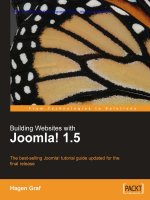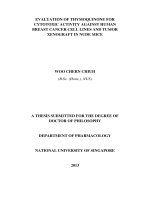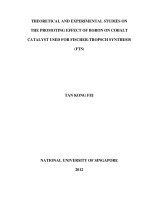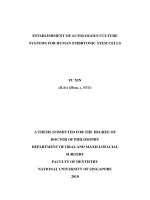Effect of culture conditions for antimicrobial activity of marine - derived fungus Aspergillus flocculosus 01NT.1.1.5
Bạn đang xem bản rút gọn của tài liệu. Xem và tải ngay bản đầy đủ của tài liệu tại đây (3.83 MB, 8 trang )
Journal of Biotechnology 15(4): 721-728, 2017
EFFECT OF CULTURE CONDITIONS FOR ANTIMICROBIAL ACTIVITY OF MARINE
- DERIVED FUNGUS ASPERGILLUS FLOCCULOSUS 01NT.1.1.5
Phan Thi Hoai Trinh1, 3, *, Ngo Thi Duy Ngoc1, Vo Thi Dieu Trang1, Phi Quyet Tien2, 3, Bui Minh Ly1, 3,
Tran Thi Thanh Van1, 3, Pham Duc Thinh1, 3, Pham Trung San1, 3
1
Nha Trang Institute of Technology Research and Application, Vietnam Academy of Science and Technology
Institute of Biotechnology, Vietnam Academy of Science and Technology
3
Graduate University of Science and Technology, Vietnam Academy of Science and Technology
2
*
To whom correspondence should be addressed. E-mail:
Received: 05.9.2017
Accepted: 25.12.2017
SUMMARY
The biosynthesis of compounds with antibiotic activity produced by marine fungi, strongly depends on
their growth conditions. A good understanding of the role of culture conditions in the biosynthesis of
metabolites may lead to better exploitation of microbial metabolites. In this study, the influence of culture
conditions including incubation period, initial pH and salinity on antimicrobial activity and secondary
metabolites production of marine fungus 01NT.1.1.5 was investigated. This isolate, obtained from sponge
Stylissa sp. in Nha Trang Bay, exhibited a broad spectrum of in vitro antimicrobial activity to Bacillus cereus
ATCC 11778, Escherichia coli ATCC 25922, Staphylococcus aureus ATCC 25923, Listeria monocytogenes
ATCC 19111, Streptococcus faecalis ATCC 19433 and Candida albicans ATCC 10231. According to
morphological characteristics and sequence analysis of 28S rDNA, the fungus was identified as Aspergillus
flocculosus. The results indicated that antimicrobial activity and metabolite amount were highest when the
fungus was cultivated in rice medium with incubation period of 20 days. The optimum salinity of 35 g/L and
initial pH of 6.0 were found for the maximum antibiotic production. The colony growth, antimicrobial activity
and production of secondary metabolites of the strain A. flocculosus 01NT.1.1.5 varied depending on salt
concentrations and initial pH of medium. Particularly, extract of this fungus only showed activity against C.
albicans when it was cultured in medium with 30-35 g/L salinity and initial pH 4.0-8.0. The results indicate
that salinity and initial pH along with cultivation period are important factors influencing antimicrobial activity
and secondary metabolites of A. flocculosus 01NT.1.1.5, and might be for other marine fungi.
Keywords: Aspergillus flocculosus, antimicrobial activity, culture conditions, marine fungi
INTRODUCTION
In recent years, wide dissemination and
emergence of multi-drug resistant bacteria have been
concerned as great impact to public health. The rise
in antibiotic resistance has been threatening to
modern healthcare (Kalyani et al., 2016; Wang et al.,
2011). Therefore, finding new antimicrobial agents,
especially those from natural resources as well as
biotechnological manipulation to increase their
activities have been strongly pursued to develop
efficient cure methods for treatment of infectious
diseases. Marine fungi have been reported as
potential sources of novel metabolites with
bioactivities such as antibiotics, antiviral, anticancer
and antioxidant (Saleem et al., 2007; Du et al., 2014).
Particularly, fungal species belonging to the genus
Aspergillus are ones of the major microbial sources
of variety of compounds with antimicrobial activity
(Li, 2010; Petersen et al., 2015). The antimicrobial
potential of Aspergillus spp. against a panel of
bacterial and fungal pathogens has been reported
(Maria et al., 2005).
The production of antibiotics by microorganisms,
including filamentous fungi can be enhanced by the
nutritional factors such as carbon and nitrogen
sources, inorganic salts with various cultivation
factors, temperature, pH, incubation period (Barakat,
Gohar, 2012). Optimization of culture conditions can
impact the quantity and diversity of metabolic
products of microbes and thus frequently has been
721
Phan Thi Hoai Trinh et al.
applied for the discovering new natural bioactive
compounds (Bills et al., 2008).
Aspergillus flocculosus 01NT.1.1.5, a marine
fungus isolated from sponge Stylissa sp. at Nha
Trang Bay. Our previous study showed that the
fungus has considerable antimicrobial activity
against a panel number of clinically significant
pathogens. In present study, we conducted the effect
of culturing conditions for this isolate in order to get
the highest antibiotic production.
MATERIALS AND METHODS
Fungal isolate
The fungus A. flocculosus 01NT.1.1.5 was
originally isolated from sponge Stylissa sp., which
was collected at Nha Trang Bay, Vietnam, in
February 2016. The fungus was identified according
to its gene sequence of 28S rDNA. The genomic
DNA of the isolate was extracted using a FastDNA
spin kit for soil (Bio 101 Systems or Q-Bio gene) by
following the company’s protocol. DNA was
amplified
using
primers
NL209
(5’AAGCGCAGGAAAAGAAACCAACAG-3’) and
NL912 (5’-TCAAATCCATCCGAGAACATCAG3’), purified with a Geneclean III kit (Q-Bio gene),
and sequenced using the fluorescent method and a
Li-COR 4200 DNA sequencer (Amodia Bioservice
GmbH, Braunschweig, Germany) (Zuccaro et al.,
2008). For identification, the sequence of the fungal
28S rDNA region were compared with those in the
NCBI (National Center for Biotechnology
Information; ). The
strain was stocked in sterile seawater with 40%
glycerol at -80 oC in the Marine Microorganism
Collection at Nha Trang Institute of Technology
Research and Application (NITRA).
Cultural and morphological properties of strain A.
flocculosus 01NT.1.1.5
The cultural properties and morphological
features of the spores and mycelia of strain A.
flocculosus 01NT.1.1.5 were examined on Czapek
medium (saccharose 30 g, NaNO3 3 g, K2HPO4 1 g,
MgSO4 0.5 g, KCl 0.5 g, FeSO4 0.1 g, agar 15 g,
seawater 1000 mL) after culturing at 28oC for 10
days (Vandermolen et al., 2013). The conidiophores
and conidia were observed with a B204 series
biological microscope (Chongqing Optec Instrument
Co., Ltd., Chongqing, China).
722
Antimicrobial assay
Antibacterial activity of ethyl acetate extracts
from the marine fungus was determined against
pathogens using disc diffusion assay (Becerro et al.,
1994). The crude extracts were impregnated at a
concentration of 100 µg/disc on to 6 mm diameter
sterile Whatman No1. discs and allowed to dry in the
air at room temperature for solvent evaporation. The
antimicrobial activity was assessed against six
pathogens, including B. cereus ATCC 11778, E. coli
ATCC 25922, S. aureus ATCC 25923, L.
monocytogenes ATCC 19111, S. faecalis ATCC
19433 and C. albicans ATCC 10231. The test
microorganisms were grown on nutrient agar media
and their density was adjusted to standard McFarland
0.5 using a spectrophotometer at a wavelength of
625 nm. Ethyl acetate without extracts in the discs
was used as negative control. The plates were
incubated at 37 °C for 24 hours and results were
recorded as zone of inhibition in mm.
Effect of culture conditions for antimicrobial
activity
The fungal strain was grown stationary at 28 oC
in 500 ml Erlenmeyer flasks, each containing 40 mL
of natural seawater collected in Nha Trang Bay (pH
8.0, salinity of 30 g/L) supplemented with 20 g of
rice, 20 mg of yeast extract, 10 mg of KH2PO4
(Sobolevskaya et al., 2016). Effects of culture
conditions
on
antimicrobial
activity
were
investigated separately for each parameter (i.e.
incubation period, pH and salinity). At the end of the
incubation period, mycelia and media were
homogenized and extracted two times with equal
volume of ethyl acetate. The extracts were then
concentrated by using rotary evaporator at 40 oC and
used as crude extracts for the test of antimicrobial
activity. Thus, growth time-dependent antimicrobial
activity of the fungus was studied by growing it in
rice media with cultivation time from 8 to 20 days
with two day intervals. The effect of salinity was
investigated at concentrations from 5 to 40 g sea
salt/L (with intervals of 5 g sea salt/L) and initial
culture medium pH from 4.0 to 9.0.
RESULTS AND DISCUSSION
Morphological
characterizations
and
identification of the strain 01NT.1.1.5
The fungal strain 01NT.1.1.5 was cultured on
Czapek medium for observation of morphological
Journal of Biotechnology 15(4): 721-728, 2017
characterization. After ten days of growth at 28oC,
the fungus had colonies of about 20 mm in diameter,
white to greyish white aerial mycelial, light yellow
to olive to brownish orange sporulation, reddish
brown soluble pigment in conspicuous and yellowish
olive exudate. Observation under light microscopy
revealed radiating conidial heads, biseriate
conidiophores, yellow to brown hyaline stipes and
globose vesicles (Figure 1).
Combination of macroscopic and microscopic
characteristics and molecular methods remain
commonly used and essential tools for identification of
Aspergillus species (Samson et al., 2014). The 28S
rDNA sequence region (796 bp) was amplified by PCR
and sequenced; BLAST search results indicated
similarity to the sequence of Aspergillus flocculosus
NRRL 5224 (GenBank accession number EU021616.1)
with a 100% identity. Moreover, the observed
morphological characteristics of this fungus are similar
to features of Aspergillus flocculosus those were
decribed by Samson et al., (2014). Thus, the fungal
strain 01NT.1.1.5 was assigned the name Aspergillus
flocculosus 01NT.1.1.5.
A
B
C
Figure 1. Colony appearance and micromorphology of A. flocculosus 01NT.1.1.5. and the sample of the sponge Stylissa sp.
(A) Sample of the sponge Stylissa sp.; (B) Colony appearance after ten days on Czapek medium; (C) Conidiophores and
conidia after ten days.
Effect of culturing conditions on antimicrobial
activity of A. flocculosus 01NT.1.1.5
fungus to reach maximum
antimicrobial metabolites.
In this study, three parameters including
incubation period, initial pH and salinity were
investigated to achieve maximum antimicrobial
activity and high yield of metabolite production by
the fungal strain A. flocculosus 01NT.1.1.5.
Generally fungal strains have different optimal
culturing time for growth and synthesis of bioactive
compounds. Particularly, the marine fungus Aspergillus
terreus var. africanus showed optimal growth time with
high antimicrobial activity at the 6th day (Barakat and
Gohar, 2012). Similarly, production of bioactive
compounds by marine fungus Cladosporium
sphaerospermum was increased gradually until reached
the maximum level after 8 days, then decreased
(Kalyani et al., 2016). However, Mabrouk et al., (2011)
reported that the marine fungus Penicillium
brevicompactum, associated algae Pterocladia sp.,
showed maxium bioactivity after 12 days of cultivation.
Effect of incubation period
Antimicrobial metabolite production by this
marine fungus was determined over a period of 26
days. The bioactive metabolite production increased
from the 12th day, reaching the highest level on 20th
day of incubation, then declined gradually (Figure 2).
Therefore, 20 day incubation was selected for the
production
of
723
Phan Thi Hoai Trinh et al.
Figure 2. Effect of incubation period on antimicrobial activity and metabolites production.
Figure 3. Effect of salinity on antimicrobial activity and metabolites production.
724
Journal of Biotechnology 15(4): 721-728, 2017
The differences in optimal incubation period for
biosynthesis of bioactive compounds in many fungi
might be due to different ecological characteristics
and growth media as well. In particular, most of the
strains reported were inoculated in broth medium
with shaking. In our study, the isolate A. flocculosus
01NT.1.1.5 was cultured in semi-solid medium with
static state. This could be the reason leading to a
longer time for growth and biosynthesis of
antibacterial compounds.
Effect of salinity
Growth and metabolite production by fungi,
especially marine fungi are largely affected by salt
concentration in the culturing media (Jingjing et al.,
2011). In our study, different concentrations of salt
in the growth medium were tested. The results
showed that strain A. flocculosus 01NT.1.1.5
obtained the highest antimicrobial activity and
metabolite production at salinity of 35 g/L (Figure 3).
Only at the salinity of 30 to 35 g/L this isolate had
inhibitory effects against C. albicans, whereas at
other salt concentrations this property was not
observed. The higher salt concentration, the more
rapid decrease of metabolite production by the strain
A. flocculosus 01NT.1.1.5.
Several authors reported that NaCl concentration
of 30 g/L was the optimal for maximum mycelia
weight and antibacterial metabolite production
(Kalyani et al., 2016). Miao et al., (2006) reported
that medium at 34 g/L salt was the best condition for
active metabolite production by the strain A.
saccharicola. Beside, NaCl concentration of 3.0 %
was also found to be optimum for maximum growth
and production of bioactive metabolite by an fungus,
Fusarium sp. (Gogoi et al., 2008). Similarly, the
marine fungus Penicillium chrysogenum was
investigated by Trinh et al., (2016) and suggested
that the fungal strain showed highest antimicrobial
activity in rice medium at salinity of 35 g/L. Cantrell
et al., (2006) found that the marine fungi with dark
cell wall can tolerate higher salinity than the
moniliaceous fungi. According to Jingjing et al.
(2011), the habitats of marine fungi had a strong
influence on their adaptation to salt.
Figure 4. Effect of initial pH on antimicrobial activity and metabolites production.
Effect of initial pH
pH values regarding to hydrogen or hydroxyl ion
concentration may affect directly on cell, or
indirectly on a degree of dissociation of substances
in the medium. Therefore, initial pH of the culture
medium affects not only growth but also
antimicrobial agent production (Singh et al., 2017).
In the present study, different initial pH values
725
Phan Thi Hoai Trinh et al.
were experimentally tested. It has been observed that
maximum antibiotic activity was obtained at pH 6.0
by A. flocculosus 01NT.1.1.5 and beyond the
optimum pH the antimicrobial activity decreased
(Figure 4). Low yield of metabolite and inactivation
towards C. albicans was showed at pH 9.0.
Acknowledgments: This study was supported by the
Grant of RV “Akademik Oparin” expedition, (VAST.
HTQT.NGA.15-06/16-17).
Similar results were reported by Mabrouk et al.
(2008), i.e. initial pH of the medium suitable for
marine fungus Varicosporina ramulosa to get the
highest bioactivity was pH 6.0. In another study, Jain
and Pundir (2011) showed that the maximum
antimicrobial activity of A. terreus against pathogens
was also found at pH 6.0. Nevertheless, a more
alkaline optimum pH of 7.5 was reported for
antibacterial activity by marine-derived fungus
Arthrinium saccharicola isolated from seawater in
Yung Shue O, Hong Kong (Miao et al., 2006). The
culture medium pH is usually not constant
throughout fungal growth and the changes might
affect the metabolite synthesis to a certain extension
(Daryaei et al., 2016; Padhi et al., 2017).
Barakat KM, Gohar YM (2012) Antimicrobial agents
produced by marine Aspergillus terreus var. africanus
against some virulent fish pathogens. Indian J Microbiol
52(3): 366–372.
Nowadays, the emergent drug resistance among
pathogenic microorganisms, increasing the rate of
microbial infections has been attracting much of
public concern (Singh et al., 2015). Discovering new
and effective antimicrobial substances from varied
natural resources, including microorganisms is an
approach to overcome the problem.
Daryaei A, Jones EE, Glare TR, Falloon RE (2016) pH
and water activity in culture media effect biological
control activity of Trichoderma atroviride against
Rhizoctonia solani. Biol Control 92: 24-30.
Production of antimicrobial agents is often
influenced by nutritional as well as cultivation
factors, which are considered as important
parameters for scale-up process in industrial
production. The optimal culture conditions for the
strain A. flocculosus 01NT.1.1.5 showed in this study
could be the first steps in study on scaling up the
production process (Bills et al., 2008).
Gogoi DK, Deka Boruah HP, Saikia R, Bora TC (2008)
Optimization of process parameters for improved
production of bioactive metabolite by a novel endophytic
fungus Fusarium sp. DF2 isolated from Taxus wallichiana
of North East India. World J Microbiolv Biotechnol 24(1):
79-87.
CONCLUSIONS
Jingjing H, Chunhua L, Xiaoming Q, Yaojian H, Zhonghui
Z, Yuemao S (2011) Effect of salinity on the growth,
biological activity and secondary metabolites of some
marine fungi. Acta Oceanol Sin 30(3): 118-123.
Our studies showed that A. flocculosus
01NT.1.1.5, a marine fungus isolated from sponge
Stylissa sp., had optimum culture conditions for
biosynthesis of antimicrobial metabolites in rice
medium with salinity of 35 g/L, initial pH 6.0 after
20 days of incubation. The results also indicated that
culture medium had a strong influence on antibiotic
activity of the isolate. Further studies on
optimization of nutritional composition for
bioactivity and metabolite production by the strain
will be carried out.
726
REFERENCES
Beccerro MA, Lopez NI, Turon X, Uriz MJ (1994)
Antimicrobial activity and surface bacterial film in marine
sponges. J Exp Mar Biol Ecol 179(2): 195-205.
Bills GF, Platas G, Fillola A, Jimenez MR, Collado J,
Vicente F (2008) Enhancement of antibiotic and secondary
metabolite detection from filamentous fungi by growth on
nutritional arrays. J Appl Microbiol 104(6): 1644–1658.
Cantrell S A, Casillas-Martinez L, Molina M (2006)
Characterization of fungi from hypersaline environments
of solar salterns using morphological and molecular
techniques. Mycol Res 110(Pt 8): 962–970.
Du FY, Zhang P, Li XM, Li CS, Cui CM, Wang BG (2014)
Cyclohexadepsipeptides of the isaridin class from the
marine-derived fungus Beauveria felina EN-135. J Nat
Prod 77(5): 1164–1169.
Jain P, Pundir RK (2011) Effect of fermentation medium,
pH and temperature variations on antibacterial soil fungal
metabolite production. J Agric Technol 7(2): 247-269.
Kalyani P, Geetha S, Hemalatha KPJ (2016) Optimization
of cultural conditions for improved production and
bioactive metabolites by Aspergillus niger (MTTC-961).
EJPMR 3(10): 255-260.
Li SM (2010) Prenylated indole derivatives from fungi:
structure diversity, biological activities, biosynthesis and
chemoenzymatic synthesis. Nat Prod Rep 27(1): 57–58.
Mabrouk AM, Kheiralla ZH, Hamed ER, Youssry AA,
Abd El Aty AA (2008) Production of some biologically
Journal of Biotechnology 15(4): 721-728, 2017
active secondary metabolites from marine-derived fungus
Varicosporina ramulosa. Malays J Microbiol 4(1): 14–24.
Mabrouk AM, Kheiralla ZH, Hamed ER, Youssry AA,
Abd El Aty AA (2011) Physiological studies on some
biologically active secondary metabolites from marinederived fungus Penicillium brevicompactum. 1: 1-15http.
Maria GL, Sridhar KR, Raviraja NS (2005) Antimicrobial
and enzyme activity of mangrove endophytic fungi of
southwest coast of India. J Agric Technol 1: 67-80.
Miao L, Kwong TF, Qian PY (2006) Effect of culture
conditions on mycelial growth, antibacterial activity, and
metabolite profiles of the marine-derived fungus
Arthrinium c.f. saccharicola. Appl Microbiol Biotechnol
72(5): 1063–1073
Padhi S, Das D, Panja S, Tayung K (2017) Molecular
characterization and antimicrobial activity of an
endolichenic fungus, Aspergillus sp. isolated from
parmelia caperata of similipal biosphere reserve, India.
Interdiscip Sci 9(2): 237–246.
Petersen LM, Kildgaard S, Jaspars M, Larsen TO (2015)
Aspiperidine oxide, a piperidine N-oxide from the
filamentous fungus Aspergillus indologenus. Tetrahedr
Lett 56(14): 1847–1850.
Phan Thi Hoai Trinh, Ngo Thi Duy Ngoc, Phi Quyet Tien,
Bui Minh Ly, Tran Thi Thanh Van (2016) Effect of
cultural conditions on antimicrobial activity of marine –
derived fungus Penicillium chrysogenum. Vietnam J
Biotechnol 14(4): 1-7.
Saleem M, Ali MS, Hussain S, Jabbar A, Ashraf M, Lee
YS (2007) Marine natural products of fungal origin. Nat
Prod Rep 24(5): 1142–1152.
Samson RA, Visagie CM, Houbraken J, Hong SB, Hubka
V, Klaassen CH, Perrone G, Seifert KA, Susca A, Tanney
JB, Varga J, Kocsubé S, Szigeti G, Yaguchi T, Frisvad JC
(2014)
Phylogeny, identification and nomenclature of
the genus Aspergillus. Stud Mycol 78:141-173.
Singh C, Parmar RS, Jadon P, Kumar A (2017)
Optimization of cultural conditions for production of
antifungal bioactive metabolites by Streptomyces spp.
isolated from soil. Int J Curr Microbiol App Sci 6(2): 386396.
Singh RP, Kumari P, Reddy CR (2015) Antimicrobial
compounds from seaweeds-associated bacteria and fungi.
Appl Microbiol Biotechnol 99(4): 1571–1586.
Sobolevskaya MP, Leshchenko EV, Hoai TP, Denisenko
VA, Dyshlovoy SA, Kirichuk NN, Khudyakova YV, Kim
NY, Berdyshev
DV, Pislyagin
EA, Kuzmich
AS, Gerasimenko
AV, Popov
RS, von
Amsberg
G, Antonov AS, Afiyatullov SS (2016) Pallidopenillines:
Polyketides from the alga-derived fungus Penicillium
thomii Maire KMM 4675. J Nat Prod 79(12): 3031-3038.
Vandermolen KM, Raja HA, El-Elimat T, Oberlies NH
(2013) Evaluation of culture media for the production of
secondary metabolites in a natural products screening
program. AMB Express 3(1): 71. doi: 10.1186/2191-08553-71.
Wang YN, Shao CL, Zheng CJ, Chen YY, Wang CY
(2011) Diversity and antibacteial activities of fungi derived
from the gorgonian Echinogorgia rebekka from the South
China Sea. Mar Drugs 9(8): 1379-1390.
Zuccaro A, Schoch CL, Spatafora JW, Kohlmeyer J,
Draeger S, Mitchell JI (2008) Detection and identification
of fungi intimately associated with the brown seaweed
Fucus serratus. Appl Environ Micobiol 74(4): 931-941.
ẢNH HƯỞNG CỦA ĐIỀU KIỆN LÊN MEN SINH HOẠT TÍNH KHÁNG SINH CỦA
CHỦNG VI NẤM BIỂN ASPERGILLUS FLOCCULOSUS 01NT.1.1.5
Phan Thị Hoài Trinh1,3, Ngô Thị Duy Ngọc1, Võ Thị Diệu Trang1, Phí Quyết Tiến2,3, Bùi Minh Lý1,3,
Trần Thị Thanh Vân1,3, Phạm Đức Thịnh1,3, Phạm Trung Sản1,3
1
Viện Nghiên cứu và Ứng dụng Công nghệ Nha Trang, Viện Hàn lâm Khoa học và Công nghệ Việt Nam
Viện Công nghệ sinh học, Viện Hàn lâm Khoa học và Công nghệ Việt Nam
3
Học viện Khoa học và Công nghệ, Viện Hàn lâm Khoa học và Công nghệ Việt Nam
2
TÓM TẮT
Sự sinh tổng hợp các hợp chất có hoạt tính kháng khuẩn tạo ra bởi vi nấm biển phụ thuộc lớn vào điều
kiện sinh trưởng của chúng. Việc làm rõ vai trò của điều kiện nuôi cấy trong quá trình tổng hợp các chất
chuyển hóa sẽ thuận lợi cho các nghiên cứu về hợp chất từ vi sinh vật. Trong nghiên cứu này, ảnh hưởng của
điều kiện nuôi cấy bao gồm thời gian nuôi cấy, pH ban đầu và độ mặn của môi trường lên hoạt tính kháng
khuẩn cũng như quá trình tạo chất chuyển hóa thứ cấp của chủng vi nấm biển 01NT.1.1.5 đã được điều tra.
Chủng vi nấm 01NT.1.1.5 được phân lập từ bọt biển Stylissa sp. thu thập tại vịnh Nha Trang, có hoạt tính
kháng khuẩn phổ rộng đối với các chủng vi sinh vật kiểm định Bacillus cereus ATCC 11778, Escherichia coli
ATCC 25922, Staphylococcus aureus ATCC 25923, Listeria monocytogenes ATCC 19111, Streptococcus
727
Phan Thi Hoai Trinh et al.
faecalis ATCC 19433 và Candida albicans ATCC 10231. Căn cứ vào đặc điểm hình thái và phân tích trình tự
28S rDNA, chủng vi nấm được xác định là Aspergillus flocculosus. Kết quả nghiên cứu cho thấy hoạt tính
kháng sinh và hàm lượng chất chuyển hóa đạt cao nhất khi chủng vi nấm được nuôi cấy trên môi trường gạo
với thời gian 20 ngày, độ mặn và pH môi trường nuôi cấy ban đầu tối ưu là 35 g/L và 6.0. Nồng độ muối và pH
ban đầu khác nhau có ảnh hưởng rõ rệt tới sinh trưởng và hoạt tính kháng khuẩn của chủng A. flocculosus
01NT.1.1.5. Cụ thể, dịch chiết của chủng vi nấm chỉ thể hiện hoạt tính kháng C. albicans khi được nuôi trong
môi trường có độ mặn 30-35 g/L và pH ban đầu 4.0-8.0. Các kết quả chứng minh rằng độ mặn và pH ban đầu
cùng với thời gian lên men là những yếu tố quan trọng quyết định hoạt tính kháng khuẩn và sự sản sinh các
chất chuyển hóa thứ cấp của chủng vi nấm biển.
Từ khóa: Aspergillus flocculosus, hoạt tính kháng khuẩn, điều kiện nuôi cấy, vi nấm biển
728









